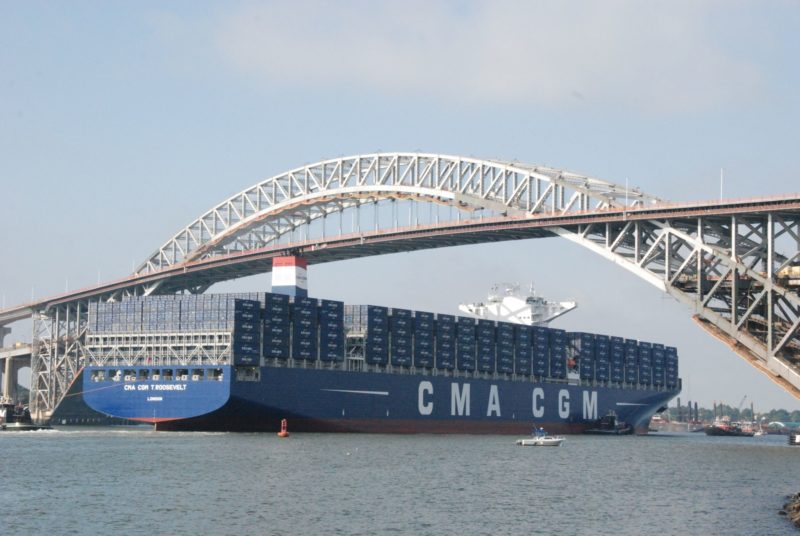The 14,414-TEU CMA CGM Theodore Roosevelt, the biggest neo-Panamax containership to call on the U.S. East Coast, made its debut in New York Harbor Thursday, transiting under the newly elevated Bayonne Bridge at Port Elizabeth, N.J.
The 1,200’x158’ Theodore Roosevelt, on its maiden voyage from Asia, drew a crowd to the Kill Van Kull to watch its bulk move down the channel between Bayonne, N.J., and Staten Island, N.Y.
Delivered by Hyundai Heavy Industries from a South Korea shipyard in July, the Roosevelt is the first in a series of six new vessels to be built for Marseille, France-based CMA CGM — since its acquisition of American President Lines, now the No. 1 container carrier to the U.S., said CMA CGM president Marc Bourdon.
Its arrival was made possible by massive infrastructure investments in the Port of New York and New Jersey, including dredging main channels to 50’ and elevating the 1931 Bayonne Bridge road deck from 151’ to 215’ over the Kill Van Kull. That permitted passage of containerships for the first time in excess of 9,800 TEUs — and sets the stage for future arrivals of 18,000-TEU ships via the widened Panama Canal.

An honor guard from the U.S. Merchant Marine Academy, Kings Point, N.Y., prepares for a welcoming ceremony for the containership CMA CGM Theodore Roosevelt. Kirk Moore photo.
“It is a game changer … it will supersize the economic engine in the New York area,” said Kevin O’Toole, chairman of the Port Authority of New York and New Jersey. “We can handle 18,000 (TEUs) here.”
O’Toole and Bourdon said the Panama Canal rebuilding and the bridge elevation were the critical infrastructure elements to bringing the next generation of super ships to East Coast ports. With them are coming new challenges for the workboat sector, with bigger, more powerful tugboats being built, and masters and pilots training to handle the ships.
The Roosevelt called earlier at Savannah, Ga., Norfolk, Va., and Charleston, S.C. — three other ports that have been working overtime to their facilities to handle bigger ships.
Regional port boosters and their business and labor allies commonly portray those trends as a competition, vying for civic and government support for dredging and other improvements. For the New York region, the port generates $53 billion annually to the economy, said O’Toole.
The canal widening will change how trade with Asia reaches North American consumers, said Jorge Quijano, CEO of the Panama Canal Authority, who traveled to New York to witness the Roosevelt’s arrival.
A ship of that class can make the passage from Shanghai to New York in 27 days, and “the only way to get in here that fast is through the Panama Canal,” Quijano told reporters gathered at the APM Terminals facility where the Roosevelt tied up. “From the West Coast, you can ship by rail to Chicago for distribution, but it is much more expensive.”
But Bourdon said there is plenty of growth potential for all U.S. ports, and downplayed the competitive aspect.
“New York and Norfolk vie for the hinterlands, but the reality is the Northeast is a very large market … there is plenty of room,” said Bourdon. “I don’t think that it’s going to change the model that already exists. It’s not going to be at the expense of the West Coast. The market is growing.”

The 984', 6,540-TEU containership CMA CGM Nerval paases the Bayonne Bridge before the original 151' high road deck was removed, in September 2016. Kirk Moore photo.
So are the ships. As CMA CGM expands its President class to six vessels, port calls at New York will be a regular Saturday arrival, said Bourdon. Beyond those, the company will add three 20,300-TEU vessels, the world’s largest, to its fleet in 2018.
APM Terminals is getting ready, with 50’ depths, new post-Panamax container cranes, and improvements to truck routing and data flow. Port Elizabeth will be able to handle up to four Roosevelt-sized vessels at once, said Jeremy H. Ford, head of commercial for APM Terminals.




